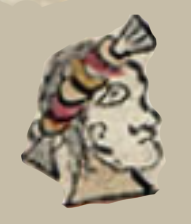cihuapilli (CST4)
This painting of the simplex glyph for the term cihuapilli (noblewoman) shows the head of a woman in profile, facing toward the viewer’s right. The companion text identifies her as doña Catalina, probably named for the patron saint of Santa Catalina Texupan. The text also makes it clear that her husband, who is behind her, is the gobernador (a term from Spanish for the head of the municipality, which in the Mixteca is called the ñuu). The gobernador would be the Indigenous ruler of Texupan. His name is not given, only hers. The noblewoman’s hair is worn in a Mixtec style, with part of it wrapped in textiles of black, red, and gold colors. In the contextualizing image, one can see that the busts of the royal couple sit atop a pyramid, an intentional architectural statement about their power. The husband and wife are also both inside the entryway to a palace, another symbol of their authority.
Stephanie Wood
For more on this cihuapilli (or yya dzehe, the equivalent in Mixtec) and, more generally, about the Codex Sierra, see Kevin Terraciano’s study (2021, but especially p. 22). The name glyph for another yya dzehe from the Mixteca appears in the Codex Quetzalecatzin (see Matlactli Omei Mazatl, below).
Stephanie Wood
1550–1564
Jeff Haskett-Wood
nobles, mujeres, pareja real

cihuapil(li), noble woman, lady, https://nahuatl.wired-humanities.org/content/cihuapilli
mujer noble, cacica, o señora natural
Stephanie Wood
Códice Sierra-Texupan, plate 4, page dated 1551. Origin: Santa Catalina Texupan, Mixteca Alta, State of Oaxaca. Kevin Terraciano has published an outstanding study of this manuscript (Codex Sierra, 2021), and in his book he refers to alphabetic and “pictorial” writing, not hieroglyphic writing. We are still counting some of the imagery from this source as hieroglyphic writing, but we are also including examples of “iconography” where the images verge on European style illustrations or scenes showing activities. We have this iconography category so that such images can be fruitfully compared with hieroglyphs. Hieroglyphic writing was evolving as a result of the influence of European illustrations, and even alphabetic writing impacted it. https://bidilaf.buap.mx/objeto.xql?id=48281&busqueda=Texupan&action=search
The Biblioteca Digital Lafragua of the Biblioteca Histórica José María Lafragua in Puebla, Mexico, publishes this Códice Sierra-Texupan, 1550–1564 (62pp., 30.7 x 21.8 cm.), referring to it as being in the “Public Domain.” This image is published here under a Creative Commons license, asking that you cite the Biblioteca Digital Lafragua and this Visual Lexicon of Aztec Hieroglyphs.


